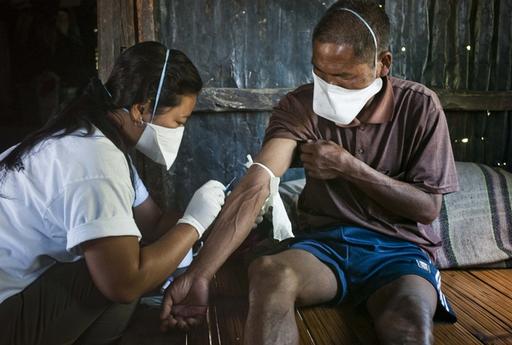The World Health Organization released its annual Global Tuberculosis report on September 18th. The report is 250 pages long, a massive conglomeration of everything we know about the current state of the Tuberculosis (TB) epidemic. It has all the newest data on TB infections, funding approaches, research into treatments, and policy approaches to stopping the epidemic.
The report tells the story of a fight we’re winning, but not fast enough. TB remains a global epidemic; it’s among the top ten causes of death globally. One-fifth of the world’s population has a latent TB infection, and every one of those people is at risk for developing active TB later in life. Still, the overall trend is mostly good. TB is no longer an automatic death sentence; we have the drugs and tools to treat the infection. But it’s not good enough. We’re not on track to meet the Sustainable Development Goals (SDG) target for tuberculosis, and new cases of tuberculosis are on the rise – not decreasing.


The Good News
Tuberculosis is less deadly than it used to be. In 2017, 16% of people with TB died from the infection. That’s a decrease from 23% in 2000. The global TB incidence rate is falling by about 2% every year. In especially good news, the WHO Euro region and the WHO Africa region – showed decreases of 5% and 4% per year respectively. Care and treatment for TB has also gotten better. A new test for TB came into common use in 2013, the Xpert MTB/RIF. Health systems and health care providers are getting better and better at using these new tests for faster, more accurate TB diagnosis.
Finally, TB incidence is falling rapidly in five African countries – by 18% in sSwatini (formerly Swaziland) 10% in Zimbabwe, 8% in Botswana, 7% in Lesotho & South Africa, and 6% in Namibia. These are among the fastest reductions seen in recent decades, and they represent the impact that good HIV treatment has on tuberculosis incidence. People living with HIV are much more vulnerable to TB infection than the population as a whole. Access to ART drugs for HIV helps to restore the immune system and reduce vulnerability to infection.
The Bad News
In 2017, 6.4 million new cases of TB were reported. That’s an increase from 2016 – the number has gone up every year since 2013. While the percentage of people who die from TB is decreasing, it needs to fall by another 10% in the next two years to meet the SDG target for TB. There is almost no possibility that we can achieve that kind of reduction.
The Really Bad News
160,184 cases of multi-drug resistant TB (MDR TB) were reported globally in 2017; an increase from the previous year. MDR TB is difficult and pensive to treat, because the TB bacteria have evolved resistance to isoniazid and rifampin, the two most potent TB drugs. MDR TB has a much higher death rate than ordinary (susceptible) TB – only about 55% of patients are successfully treated, compared to over 80% among people infected with susceptible TB.
Treating MDR TB also takes longer, making people more likely to leave treatment before they’re finished and put their communities at risk of infection. In 2017, almost half of all MDR TB cases were in three countries; India, Russia, and China. Among those 160,184 cases of MDR TB, about 8.5% were infected with extensively drug resistant TB (XDR TB). XDR TB is resistant to more than four TB drugs. XDR cases are difficult, sometimes impossible to treat.
Globally, 3.6% of new TB cases were drug-resistant. That’s a very bad sign. Normally, a patient ends up with drug-resistant TB when their susceptible TB is treated incorrectly. Maybe they get the wrong drugs, or maybe they quit their treatment early. Whatever happens, their treatment puts enough pressure on their bacteria colony for resistance to evolve – and not enough pressure to get rid of the infection. That kind of drug resistance can be prevented through better patient care. In those 3.6% of cases, though, their first TB infection was resistant to drugs. That’s a much more challenging situation to address.
What does it all mean?
Tuberculosis is still a poor person’s disease. In 2017, there were fewer than 10 cases of TB per 100,000 people in higher-income countries, compared to 150-500 cases per 100,000 in the rest of the world. The list of the 30 countries with a high TB burden was made up entirely of lower income and middle-income countries. Globally, there were approximately ten million cases of TB in 2017, about 133 cases per 100,000 people.
If it’s a poor person’s disease, though, that means money could solve the problem. Two out of the report’s eight chapters are devoted to the finances behind fighting the epidemic, and there’s a reason for that. Right now, we’re not investing the money needed to solve it. For 2018, there is a gap of over three billion dollars between the financing needed to fight the epidemic and the funds that are actually available. If trends don’t change, the gap will be over six billion dollars by 2022.
In global health, we talk about “commitment,” a lot. Most of the time, though, commitment just means money. And money is what’s needed here. Money to support research into a better TB vaccine, money to find new diagnostic technologies, money to support MDR and XDR TB treatment. We stop a TB epidemic by diagnosing TB quickly in people who are infected, and then getting them started in the correct treatment as fast as possible. Better technology and treatments would help, but we’ve got enough tools already if we just had the funds to fully deploy them.
